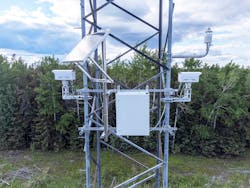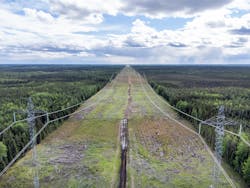Investigating Flashovers on HVDC Transmission Lines
High voltage direct current (HVDC) lines transmit power over long distances in Manitoba, Canada. Back in the 1970s, when Manitoba Hydro first energized the Bipole 1 and II HVDC lines, the utility started noticing unexplained flashovers, which are electrical discharges from energized conductors to ground.
These flashovers occurred mainly in the remote northern portion of its service territory, in the afternoon or early evening, during the summer months, mainly from July to August, and only on the negative poles during steady state conditions with no switching surge.
“We have up to 40 of these events in the summer, and they have occurred since the inception of the lines,” said Jeff Laninga, live line and electrical effect section head at Manitoba Hydro. “They were thought to be preceded by precipitation and light winds at the time of the event.”
Following a flashover, an HVDC system can recover from the faults in a blink of an eye, Laninga said, but there are consequences. For example, live line work is prohibited between May to October on Manitoba Hydro’s on affected HVDC transmission lines. No safety hold-offs are normally given because a fault would result in an outage, and an Emergency Energy Purchase could cost as much as $1 million. Daily outage costs can soar up to $500,000. In addition, the flashovers can delay large, energized maintenance projects, could ignite wildfires or pose risks of arc flash events for workers.
Installing Monitoring Systems
The 1800 MW Bipole I, which has been in service since 1972, spans 895 km, and the 2000 MW Bipole II, installed in 1978, measures 937 km. Four years ago, the utility also constructed the 2000 MW Bipole III, which is 1,400 km long. Large portions of these lines are situated in a remote location with no communications, no AC power and difficult terrain.
Back in 1996, the utility made its first attempt to capture a flashover event using video cameras, VCRs, solar panels and batteries for a total of 12 systems. The video had to be retrieved within 24 hours of an event by helicopter, and only two lightning strikes were captured.
To better understand the problem, Manitoba Hydro worked with Ai4 Technologies and AISPECO to install five camera systems in historically active locations. The team monitored the flashovers through daily LiDAR technology, environmental sensors and 10 hours of video recording at times of interest.
“We put the five systems fairly close together and concentrated in the region,” Laninga said. “I chose structure locations with the most active historical events.”
On the towers, Manitoba Hydro installed a cabinet, batteries, cameras and a satellite dish for system monitoring and remote data transfer. Environmental sensors measured air pressure, particulate matter, solar radiation, humidity, wind speed and direction and rain. The utility also installed a solar panel that tilted
facing south for maximum sun exposure.
“We captured a flashover with the monitoring system on July 20, 2021, and the photo shows an intense arc on the negative pole on the right-hand side,” Laninga said. “At the end of the event, you can see the arc dissipating and getting weaker as the system does a fast restart.”
To locate the flashover point in LiDAR, the team relied upon spacer dampers, which provided a reference point. “Conductors and rope can only follow a certain curve called a catenary,” he said.
Reflecting on the Data
Using a cloud-based application, Manitoba Hydro and team then analyzed the data. It took many days of analysis to review the images from the LiDAR
system, which was part of the fixed tower system, as well as the environmental sensors on the structures. LiDAR only provided a limited number of reflections
from the conductor. Laninga said this is typical because the measurement angle of the LiDAR is not optimal when it is measuring the conductor from the tower.
“Most of the reflections reflect away from the LiDAR sensors,” he said. “The vegetation, however, has more surface to provide greater diffusion.” By measuring the distance to the vegetation from the fitted curve, Manitoba Hydro discovered the closest point between the vegetation and the curve is about 15 ft to 18 ft. At the utility, the Minimum Approach Distance (MAD) for 500 kV HVDC is 10 ft, and the Minimum Air Insulation Distance based on standards with no switching surge is 3.5 ft. Also, the NERC MVCD (minimum vegetation clearance distance) is 8 ft for 500 kV DC. “It is known that flashovers occur in areas where vegetation has recently been cleared and in areas where there is limited vegetation,” Laninga said.
Looking Ahead
Since Bipole III was put into service in 2018, no unexplained flashovers have occurred. The line was designed and constructed with increased insulation length, taller structures for increased clearance and a three-bundle configuration to reduce the voltage gradient stress.
Through further research on the lines, Manitoba Hydro discovered that the flashovers are shown to occur midspan on sunny days in the summer months at the warmest part of the day. They also occur over large clearance distances greater than MAD and MVCD.
“Computer monitoring and vision technology has been shown to be able to continuously monitor the environment and assets in remote locations with no need for helicopter transportation, existing cell phone towers/communications and no power source,” Laninga said.
At this point in time, however, further data collection is required. Also, more work is required on standards related to space charge and HVDC for live line work as it is currently mainly based on HVAC testing. The utility is also examining the impact of smoke on air conductivity and live working and clearance distances through field sensors and high-voltage laboratory tests.
“I want to study the impact of smoke on air conductivity,” Laninga said. “Air becomes more conductive with smoke versus no smoke and is another variable that only exists in the warmer in months. There are no tools that exist currently prior to live line work for linemen to assess this risk. It is expected with climate change that wildfires and smoke around transmission lines will increase.”
In the future, Manitoba Hydro will be studying the flashovers in a high-voltage laboratory through full-scale and small- scale testing to replicate the phenomenon and attempt to mitigate the issue in the most cost-effective way.
Editor’s Note: To listen to a Line Life podcast featuring an interview with Jeff Laninga of Manitoba Hydro on Manitoba Hydro’s research on flashovers, visit https://anchor.fm/line-life-podcast.
Amy Fischbach is the Field Editor for T&D.World magazine.
About the Author
Amy Fischbach
Electric Utilities Operations
Amy Fischbach is the Field Editor for T&D World magazine and manages the Electric Utility Operations section. She is the host of the Line Life Podcast, which celebrates the grit, courage and inspirational teamwork of the line trade. She also works on the annual Lineworker Supplement and the Vegetation Management Supplement as well as the Lineman Life and Lineman's Rodeo News enewsletters. Amy also covers events such as the Trees & Utilities conference and the International Lineman's Rodeo. She is the past president of the ASBPE Educational Foundation and ASBPE and earned her bachelor's and master's degrees in journalism from Kansas State University. She can be reached at [email protected].


